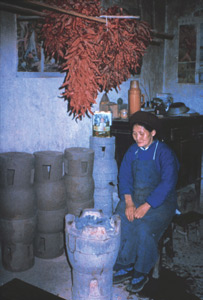Arsenic
is a persistent toxin that
occurs naturally in trace
amounts in rocks, sediments,
and coal. Small amounts of
arsenic may be present in
ground water or, less commonly,
surface waters, especially
where there is a nearby source
of arsenic. The most widespread
natural source of arsenic
is pyrite, a common mineral
composed of iron and sulfur,
which can contain a small
amount of arsenic in its
structure in place of sulfur.
Arsenic
occurs in some ground-water
aquifers due to chemical
oxidation of pyrite or
to reduction (the opposite
of
oxidation) of iron oxide
minerals in the aquifer.
Other
sources
of arsenic include past
industrial
activities, application
of
arsenic as a pesticide,
and
drainage from abandoned
mine
lands that contain pyrite.
Prolonged consumption of
drinking water from wells
that greatly exceed arsenic
health standards is the
most
serious arsenic-related
health
hazard in the United States
and throughout the world.
Arsenic
in bituminous coal occurs
primarily in pyrite and,
to a lesser extent, in
organic
portions of the coal. A
small
fraction of this arsenic
is emitted during coal
combustion.
This Fact Sheet provides
information
on the arsenic content
of
U.S. coals, how arsenic
occurs,
and its behavior during
mining,
coal preparation, and coal
combustion and in postcombustion
beneficial
uses. |
|
 |
VIEW the
report [4.4-MB PDF file]
| DOWNLOAD Adobe
Reader free of charge |
|
Interior
view of residence in southwestern
Guizhou Province, China,
where arsenic-rich coal and
coal briquettes are used
to dry crops (chili peppers)
that are later consumed,
resulting in arsenic toxicity. |


